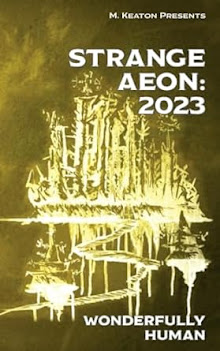"Psst, boss."
"I'm on it already."
One of the earliest Dark Matter theories was that of MACHOs.
MACHOs--Massive Compact Halo Objects; theorized massive compact objects the size of small stars formed of dark matter and present in the outer reaches (halos) of galaxies. May be formed of Mirror Matter. This theory most likely still does not provide sufficient "dark matter" to explain observed gravimetric phenomena.
But wait, you say, what's this about Mirror Matter? Is that the universe with the evil Kirk in it?
Well, maybe but not quite. To go much further, we'll have to run through some related, supporting theories and definitions.
Supporting theories:
Negativity--When Dirac discovered electron spin, a problem arose in the equations. Since the equation employed a square root, it allowed for a solution both positive and negative. (The square root is present because Einstein's relativity equation uses the speed of light squared.) That is, mathematically, electrons could possess negative energy. This led him to propose antimatter (matter possessed of negative energy) and the further theory of antiparticles in general. The antielectron or positive electron (positron) is supposed to be observed in the form of cosmic rays.
This lead to the idea of Mirror Matter via the Symmetry argument.
Mirror Matter--Every type of particle in nature has a mirror partner that is utterly invisible (does not interact with light) and can be detected only by its gravity.
SUSY--Supersymmetry. A mathematical framework now accepted as proven that proposes, as a function of the principle of conservation of energy, the net state of the universe must be zero-sum and have particular, physical symmetry. Actual experimental evidence of SUSY is effectively non-existent despite the common assumption of its infallibility. The primary argument in its favor is the philosophical principle that math arises from the forms of nature. Rather than simply a human invention for book-keeping, math is an intrinsic part of the natural form observed and recorded by humans.
Which in turn gives us the nomenclatural nightmare of Sparticles.
Sparticles--Supersymmetric partner particles. The theory that there exists a new subatomic partner for every kind of particle now known within the quantum dimensions (sizeless dimesnions). SUSY quantum theory adds the idea of a fermionic dimension as well as the traditional, observable bosonic dinension. Fermionic (fundamental matter particles) and bosonic (fundamental force particles) particles are necessary to support SUSY via the argument that force and matter are to aspects of the same thing (again, a legacy of Einstein). This argument has merit, beyond merely E=mc2, since the defining feature of a boson vs. a fermion is simply spin. Sparticles are named by placing an 's' in front of the particle they theoretically partner with. I. E. quarks and squarks. Force Sparticles gain 'ino' at the end. I. E. photons and photinos.
Next Time: WIMPs, SIMPs, and Q-Balls!
Thursday, January 15, 2009
Monday, January 12, 2009
Dark Matter, What and Why
"This thing ready, cat?"
"Whenever you are."
"Right, let's get on with it then..."
Let's start of with: Why Dark Matter and What is it?
Dark Matter--Some heavy stuff we can't detect floating around in space. Cosmologists believe its existence is necessary because otherwise all their fancy schemes fall apart. Specifically, the calculable mass of matter in the universe is insufficient to account for the gravimetric effects observed on numerous fronts. Therefore, there must be matter that we are not detecting. I know that sounds like an oversimplification but that's really what it comes down to if you boil away the hype.
Remember when I mentioned circular assumptions? Dark Matter may turn out to be one of the greatest circular assumptions of all time. The entire Dark Matter discussion is predicated on the assumption that our current understanding of gravity is correct and that Einstein's theory of general relativity is also correct. Further, Dark Matter is automatically a metaphysical theory, rather than a scientific physical one, because as yet we can detect no evidence and may never be able to beyond inference. This is a good example of why metaphysics is a fine and useful tool and should not be shoved into the gutter as many scientists today try to do. Without the metaphysical postulation of Dark Matter, we cannot derive hypotheses or experiments to look for Dark Matter and could therefore never elevate it into the category of scientific investigation. In other words, without the roots of metaphysics—the schemes and dreams of 'what if'—we could not make scientific progress. Despite its pre-scientific trappings, Dark Matter is a metaphysical or pseudo-scientific theory (or set of theories) at this point. There is nothing wrong with this so long as we understand that it is in the "pre-science" stage rather than running to the media, pointing to the sky and yelling "Lo, I have found a new thing, proven by science!" (Small Charles Fort reference there for your amusement.)
Next Time: MACHOs!
"Whenever you are."
"Right, let's get on with it then..."
Let's start of with: Why Dark Matter and What is it?
Dark Matter--Some heavy stuff we can't detect floating around in space. Cosmologists believe its existence is necessary because otherwise all their fancy schemes fall apart. Specifically, the calculable mass of matter in the universe is insufficient to account for the gravimetric effects observed on numerous fronts. Therefore, there must be matter that we are not detecting. I know that sounds like an oversimplification but that's really what it comes down to if you boil away the hype.
Remember when I mentioned circular assumptions? Dark Matter may turn out to be one of the greatest circular assumptions of all time. The entire Dark Matter discussion is predicated on the assumption that our current understanding of gravity is correct and that Einstein's theory of general relativity is also correct. Further, Dark Matter is automatically a metaphysical theory, rather than a scientific physical one, because as yet we can detect no evidence and may never be able to beyond inference. This is a good example of why metaphysics is a fine and useful tool and should not be shoved into the gutter as many scientists today try to do. Without the metaphysical postulation of Dark Matter, we cannot derive hypotheses or experiments to look for Dark Matter and could therefore never elevate it into the category of scientific investigation. In other words, without the roots of metaphysics—the schemes and dreams of 'what if'—we could not make scientific progress. Despite its pre-scientific trappings, Dark Matter is a metaphysical or pseudo-scientific theory (or set of theories) at this point. There is nothing wrong with this so long as we understand that it is in the "pre-science" stage rather than running to the media, pointing to the sky and yelling "Lo, I have found a new thing, proven by science!" (Small Charles Fort reference there for your amusement.)
Next Time: MACHOs!
Subscribe to:
Comments (Atom)




















